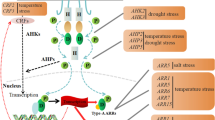Abstract.
Hypocotyls of the diageotropica (dgt) mutant of tomato (Lycopersicon esculentum Mill.) do not elongate in response to exogenous auxin, but can respond to gravity. This appears paradoxical in light of the Cholodny-Went hypothesis, which states that shoot gravicurvature results from asymmetric stimulation of elongation by auxin. While light-grown dgt seedlings can achieve correct gravitropic reorientation, the response is slow compared to wild-type seedlings. The sensitivity of dgt seedlings to inhibition of gravicurvature by immersion in auxin or auxin-transport inhibitors is similar to that of wild-type plants, indicating that both an auxin gradient and auxin transport are required for the gravitropic response and that auxin uptake, efflux, and at least one auxin receptor are functional in dgt. Furthermore, dgt gravicurvature is the result of asymmetrically increased elongation as would be expected for an auxin-mediated response. Our results suggest differences between elongation in response to exogenous auxin (absent in dgt) and elongation in response to gravistimulation (present but attenuated in dgt) and confirm the presence of two phases during the gravitropic response, both of which are dependent on functional auxin transport.
Similar content being viewed by others
Author information
Authors and Affiliations
Additional information
Received: 16 July 1999 / Accepted: 24 September 1999
Rights and permissions
About this article
Cite this article
Rice, M., Lomax, T. The auxin-resistant diageotropica mutant of tomato responds to gravity via an auxin-mediated pathway. Planta 210, 906–913 (2000). https://doi.org/10.1007/s004250050696
Issue Date:
DOI: https://doi.org/10.1007/s004250050696




